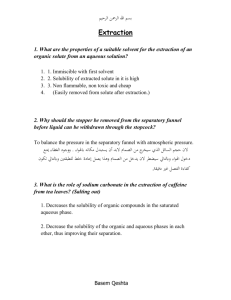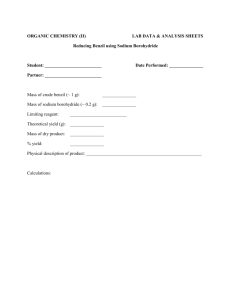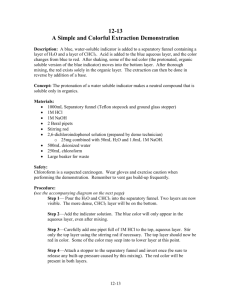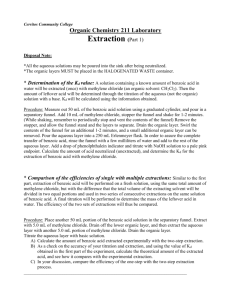Brian Andersen S343 Acid-Base Extraction 2/16/2012 1.) 2
advertisement
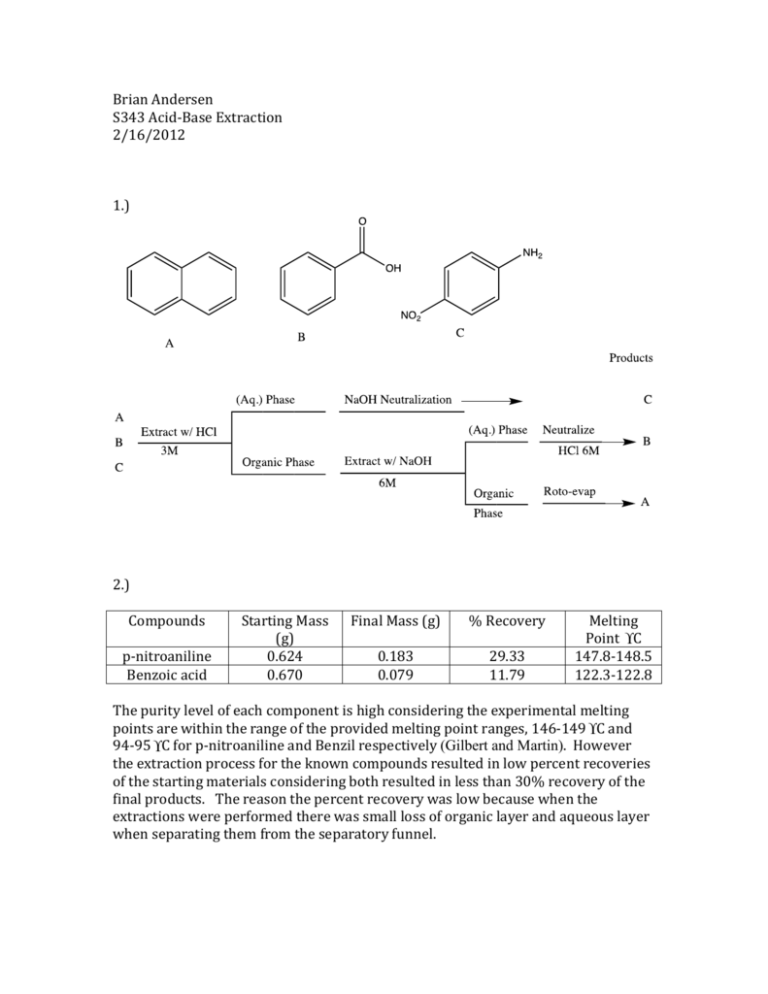
Brian Andersen S343 Acid-Base Extraction 2/16/2012 1.) 2.) Compounds p-nitroaniline Benzoic acid Starting Mass (g) 0.624 0.670 Final Mass (g) % Recovery 0.183 0.079 29.33 11.79 Melting Point ° C 147.8-148.5 122.3-122.8 The purity level of each component is high considering the experimental melting points are within the range of the provided melting point ranges, 146-149 ° C and 94-95 ° C for p-nitroaniline and Benzil respectively (Gilbert and Martin). However the extraction process for the known compounds resulted in low percent recoveries of the starting materials considering both resulted in less than 30% recovery of the final products. The reason the percent recovery was low because when the extractions were performed there was small loss of organic layer and aqueous layer when separating them from the separatory funnel. 3.) 4.) Based upon the data collected and experimentally determined melting points of the unknown components that were collected through extraction the first unknown extracted from the component was p-nitroaniline. The melting point was 143-146.1 ° C, which is in the relative range of p-nitroaniline of 146-149 ° C provided by (Gilbert and Martin). P-nitroaniline is the only plausible base that could be the unknown because it has the highest melting point of all the unknowns; it was neutralized with acid to obtain a neutral pH yielding a yellow crystalline solid upon vacuum filtration. The other unknown extracted was Benzil, which has a melting point range of 94-95 ° C; the experimentally determined melting point was 94-96.2 ° C, indicating the unknown neutral compound was Benzil (Gilbert and Martin). 5.) My partner for this lab was Tom Gallmeyer. Tom performed the known the acidbase extraction on the known samples and I performed the acid-base extraction on the unknown samples. No, we would not have changed the division of labor, having two people perform each reaction was time efficient and effective. 6.) When performing an acid-base extraction it is imperative to vent the separatory funnel frequently because shaking the organic layer and aqueous layer creates a lot of pressure in a closed system. Pressure is created because the mixing causes an increase in entropy in the closed system. When venting is performed the separatory funnel releases the pressure of the system preventing the top from shooting out potential shattering of the glassware due to excess pressure build up. It is necessary to remove the stopper when draining the aqueous layer because with the stopper still in the components will not separate as well because the stopper creates a suction system in the funnel if it is not removed. By removing the stopper the layers can freely separate, furthermore if the stopper is not removed it will be much more time consuming to separate the layers. 7.) To correctly identify the aqueous layer without any knowledge of density or how an acid-base extraction works, one could simply add more water to the separatory funnel and whichever components volume increased would indicate what the aqueous layer. One could also separate the two layers and add water to see which one forms a second layer, which would also indicate the organic and aqueous phases. 8.) Drying agents are hygroscopic solids that remove moisture from an environment or in this case remove water from the products formed from the acid base extraction. The drying agent absorbs water molecules form the organic layer by binding to water molecules, organic layers are typically insoluble in water due to water’s high polarity and thus drying agents are also insoluble in water and can absorb the water present. Drying agents are necessary to remove water from an organic solution; whenever organic solutions have been exposed to water they must be introduced to a drying agent to absorb all water molecules present. This is crucially important if one was performing a Grignard reaction or a reaction with LAH, where when exposed to water these reagents will react violently upon interacting, which reiterates the importance of drying agents. 9.) Some general rules for solubility for performing extractions are hydrophilic molecules will dissolve in polar solvents and hydrophobic molecules will be soluble in non-polar solvents, solubility is always favored when entropy increases, this is one of the key reasons extraction works so well to purify or extract compounds. A few variables have to be taken into consideration though, mainly the solubility product (Ksp), for solvating salts, the negatively charged anions in salts are attracted to the partial positive on hydrogen and the positively charged cations that make up the salt are attracted to the partial negative on the oxygen when interacting with water. The higher the Ksp value the more soluble the salts will be in water and thus more readily able to ionize upon solvation. 10.) References Cited Gilbert, John C., and Stephen F. Martin. Experimental Organic Chemistry: A Miniscale and Microscale Approach. 5. Boston: Brooks Cole, 2010. Print.

